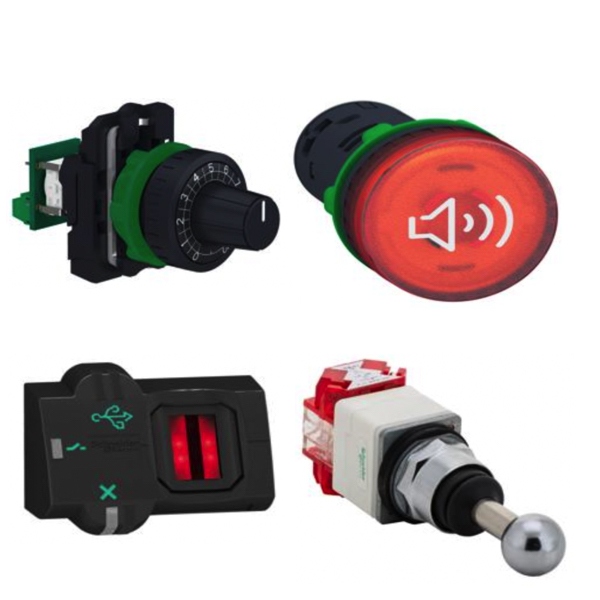Push Buttons, Switches & Signaling Devices

RSP Supply carries a complete selection of push buttons, switches, and signaling devices built for industrial control, automation, and machine interface applications. These components are essential for starting, stopping, or signaling processes, ensuring operators can safely and efficiently manage systems across manufacturing, HVAC, and process industries.
Push buttons act as mechanical switches that open or close electrical circuits, typically used for start-stop control functions. Many models feature integrated indicator lights to display operational status at a glance. Selector switches provide manual control through rotary handles, available in 2- or 3-position options with or without key locks for secure operation. Foot switches, or pedals, enable hands-free activation, offering safe and efficient operation in applications like machine tooling or medical equipment. Signaling devices - including beacons, buzzers, pilot lights, sounders, and strobes - provide clear visual and audible alerts to indicate equipment status, faults, or process conditions. Control stations combine multiple components (such as push buttons and pilot lights) in a rugged, enclosed housing for reliable field operation.
Advanced options like potentiometers allow manual voltage adjustments, while biometric switches add secure access control using fingerprint recognition. For motion-based control, joysticks convert directional movement into electrical output signals through inductive or photoelectric sensing. Together, these devices form the backbone of safe and efficient industrial control systems.
FAQs
Q: What is the function of a push button switch?
A push button switch opens or closes an electrical circuit to start or stop machine functions, commonly used in industrial control panels and automation systems.
Q: What is the difference between a selector switch and a push button?
A selector switch allows operators to choose between multiple settings (e.g., ON/OFF/AUTO), while a push button performs a single action such as starting or stopping a motor.
Q: What are signaling devices used for?
Signaling devices like beacons, buzzers, and pilot lights provide visual or audible alerts to indicate system status, warnings, or maintenance needs.
Q: Are foot switches suitable for industrial use?
Yes. Foot switches are designed for hands-free control in demanding environments and are built with rugged housings for safety and durability.
Q: Does RSP Supply carry control stations with pre-installed components?
Yes. RSP Supply offers pre-configured control stations equipped with push buttons, pilot lights, and selector switches for quick installation and reliable performance.
Why Buy Push Buttons, Switches, and Signaling Devices from RSP Supply
At RSP Supply, we provide trusted industrial control solutions that meet the highest standards for safety, reliability, and performance. Our lineup includes top brands like Schneider Electric, IDEC, Eaton, and ABB, ensuring compatibility with modern automation systems.
With competitive pricing, expert technical support, and same-day shipping, RSP Supply helps you get the components you need - fast. Whether you’re building new systems or maintaining existing ones, we make control easy, reliable, and efficient.

